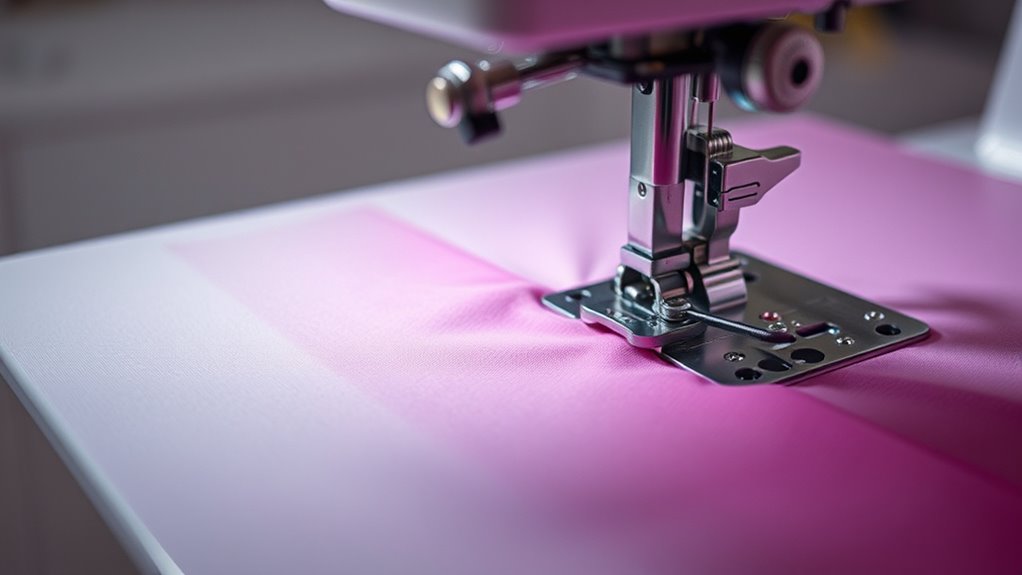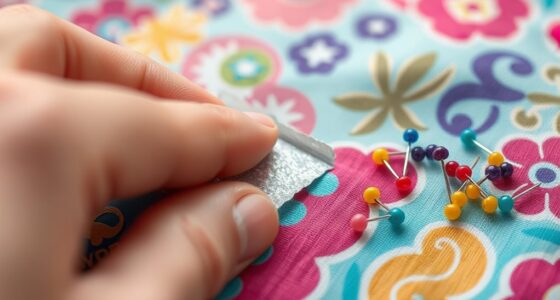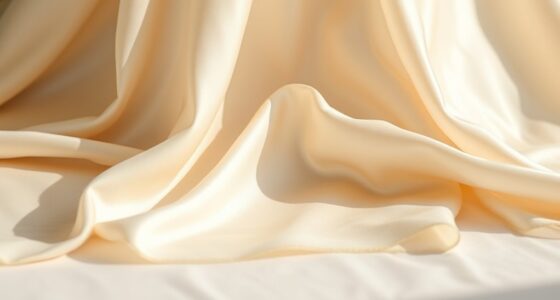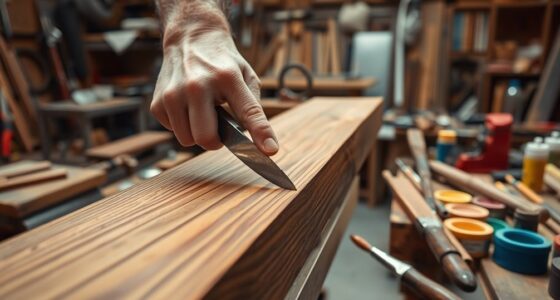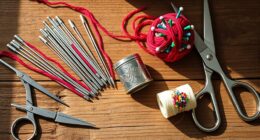To avoid stretch fabric distortion, adjust your differential feed properly. Increasing the differential feed reduces fabric pulling and prevents puckering, while decreasing it helps avoid bunching. Make small adjustments based on your fabric’s stretch qualities and sew at a slow speed for better control. Using the right needles and stretch stitches also helps maintain smooth, even seams. Keep experimenting with these settings, and you’ll discover how to achieve professional results every time.
Key Takeaways
- Adjust the differential feed to match the fabric’s stretch to prevent puckering or distortion.
- Increase differential feed for stretchy fabrics to reduce pulling and maintain fabric stability.
- Use appropriate stretch or ballpoint needles alongside differential feed for smooth sewing.
- Sew at slower speeds to better control fabric movement and minimize distortion.
- Combine proper tension, stitch type, and differential feed settings for optimal fabric stability.
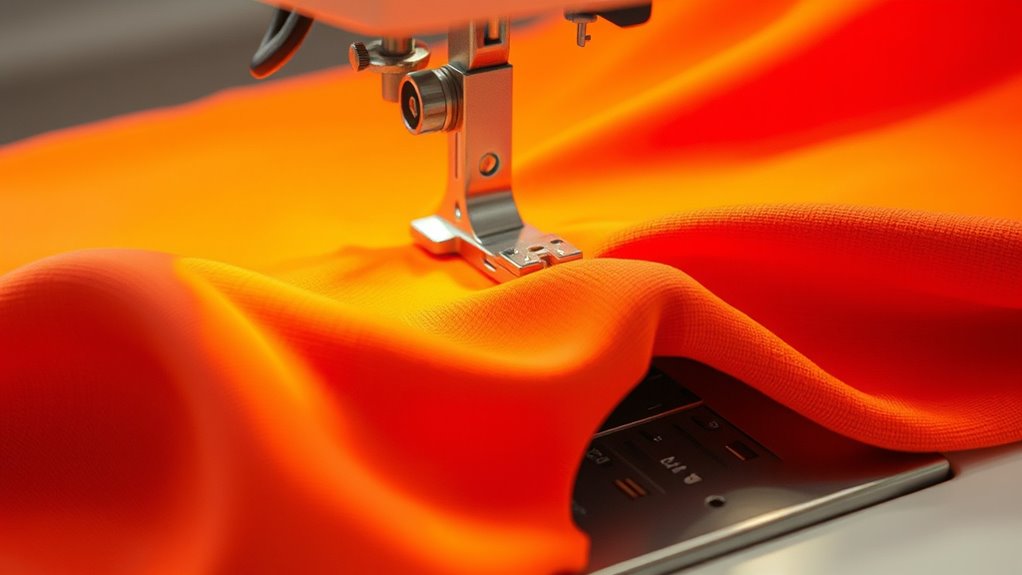
Stretch fabric is popular for its comfort and flexibility, but it can easily become distorted if you’re not careful. One common challenge with stretch material is maintaining fabric stability during sewing. Without proper control, the fabric can shift, stretch out of shape, or produce uneven seams, making your finished project look unprofessional. To keep things on track, understanding how to manage fabric stability and seam accuracy is vital. A key technique to achieve this is using differential feed on your sewing machine.
Maintaining fabric stability during sewing ensures professional, even seams on stretch fabrics.
Differential feed is a feature that controls the movement of the fabric layers as they pass through your machine. It ensures that the top and bottom layers feed evenly, preventing puckering, stretching, or gathering. When sewing stretch fabric, setting the differential feed correctly is essential. If you notice the fabric pulling or becoming distorted as you sew, increasing the differential feed can help. Conversely, if the fabric gathers or bunches, decreasing it will improve fabric stability. Adjusting this setting allows you to fine-tune the fabric’s movement, resulting in smoother seams and more precise stitching.
By maintaining fabric stability through differential feed, you help guarantee seam accuracy. When the fabric remains consistent and stable as it feeds through your machine, your stitches stay even and straight. This reduces the need for seam ripping and re-sewing, saving you time and frustration. Proper tension and feed settings work together to prevent the fabric from stretching or shifting, which is especially important with stretch fabrics that tend to be more prone to distortion. Additionally, understanding the mechanics of asset division can help inform decisions on how to best allocate and manage fabric and resources during your projects.
Furthermore, using the right needle and stitch type complements the differential feed. A stretch or ballpoint needle minimizes skipped stitches, while a zigzag or stretch stitch accommodates the fabric’s natural elasticity. These adjustments, combined with differential feed, help keep the fabric stable throughout the sewing process. Remember to sew slowly, especially when starting out, to better control the fabric and observe how it reacts to your machine’s settings.
Frequently Asked Questions
Can Differential Feed Be Used on All Sewing Machines?
You might wonder if differential feed works on all sewing machines. Not every machine has this feature, so sewing machine compatibility varies. While many industrial and advanced models include differential feed, some basic or older machines don’t support it. Be aware of differential feed limitations; check your machine’s manual to confirm if it offers this function. Using it correctly helps prevent fabric distortion, especially with stretch or delicate fabrics.
What Types of Stretch Fabrics Are Most Prone to Distortion?
You’ll find that stretch fabrics like spandex, lycra, and jersey are most prone to distortion because of their fiber stability and fabric recovery. These fabrics stretch easily but can lose their shape if not sewn carefully. To prevent this, you should use proper tension, a stretch needle, and adjust your machine settings. Differential feed can help, but understanding fabric properties guarantees you maintain its original shape and avoid distortion.
How Do I Adjust My Machine’S Differential Feed Settings?
Think of your sewing machine as a conductor, and the differential feed as the tempo. To adjust it, first perform regular sewing machine maintenance, ensuring smooth operation. Then, analyze your fabric’s stretch properties—tight or loose. Turn the differential feed dial or sliders slowly, testing on scrap fabric until stitches are even and distortion-free. Proper adjustment keeps your fabric’s stretch in harmony, preventing distortion and ensuring professional results.
Are There Specific Needles Recommended for Stretch Fabrics?
When sewing stretch fabrics, you should use a stretch needle or a ballpoint needle. These needles have a rounded tip that glides between fabric fibers, preventing runs and puckering. A stretch needle is specifically designed for stretchy materials, while a ballpoint needle works well for knits and jersey. Using the right needle guarantees smooth sewing and helps avoid fabric distortion, especially when combined with proper tension and stitch settings.
How Does Fabric Stretch Direction Affect Differential Feed Choices?
Imagine your fabric as a dance partner, moving gracefully along its natural grain or stretching on a bias. Your differential feed choice must follow this rhythm, aligning with the fabric’s stretch direction. When sewing stretch fabric, set your differential feed to accommodate the fabric grain or stretch bias, preventing distortion. This guarantees smooth, professional results, allowing your fabric to glide seamlessly without puckers or stretching out of shape.
Conclusion
By using differential feed, you can keep your stretch fabrics looking flawless and avoid unwanted distortion. Isn’t it worth the extra step to guarantee your garments stay perfect? Remember, paying attention to your sewing machine settings makes all the difference. With a little care and the right technique, you’ll achieve professional-looking results every time. So, next time you sew stretch fabrics, ask yourself: why settle for less when you can master the art of perfect stitching?
